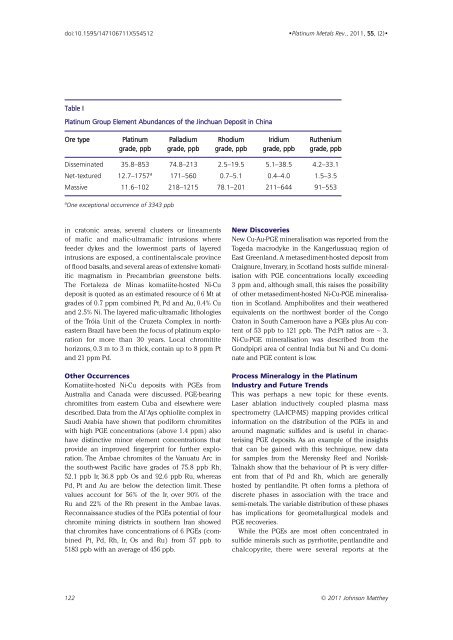Download - Platinum Metals Review
Download - Platinum Metals Review
Download - Platinum Metals Review
Create successful ePaper yourself
Turn your PDF publications into a flip-book with our unique Google optimized e-Paper software.
doi:10.1595/147106711X554512<br />
•<strong>Platinum</strong> <strong>Metals</strong> Rev., 2011, 55, (2)•<br />
Table I<br />
<strong>Platinum</strong> Group Element Abundances of the Jinchuan Deposit in China<br />
Ore type <strong>Platinum</strong> Palladium Rhodium Iridium Ruthenium<br />
grade, ppb grade, ppb grade, ppb grade, ppb grade, ppb<br />
Disseminated 35.8–853 74.8–213 2.5–19.5 5.1–38.5 4.2–33.1<br />
Net-textured 12.7–1757 a 171–560 0.7–5.1 0.4–4.0 1.5–3.5<br />
Massive 11.6–102 218–1215 78.1–201 211–644 91–553<br />
a One exceptional occurrence of 3343 ppb<br />
in cratonic areas, several clusters or lineaments<br />
of mafic and mafic-ultramafic intrusions where<br />
feeder dykes and the lowermost parts of layered<br />
intrusions are exposed, a continental-scale province<br />
of flood basalts,and several areas of extensive komatiitic<br />
magmatism in Precambrian greenstone belts.<br />
The Fortaleza de Minas komatiite-hosted Ni-Cu<br />
deposit is quoted as an estimated resource of 6 Mt at<br />
grades of 0.7 ppm combined Pt, Pd and Au, 0.4% Cu<br />
and 2.5% Ni. The layered mafic-ultramafic lithologies<br />
of the Tróia Unit of the Cruzeta Complex in northeastern<br />
Brazil have been the focus of platinum exploration<br />
for more than 30 years. Local chromitite<br />
horizons, 0.3 m to 3 m thick, contain up to 8 ppm Pt<br />
and 21 ppm Pd.<br />
Other Occurrences<br />
Komatiite-hosted Ni-Cu deposits with PGEs from<br />
Australia and Canada were discussed. PGE-bearing<br />
chromitites from eastern Cuba and elsewhere were<br />
described. Data from the Al’Ays ophiolite complex in<br />
Saudi Arabia have shown that podiform chromitites<br />
with high PGE concentrations (above 1.4 ppm) also<br />
have distinctive minor element concentrations that<br />
provide an improved fingerprint for further exploration.<br />
The Ambae chromites of the Vanuatu Arc in<br />
the south-west Pacific have grades of 75.8 ppb Rh,<br />
52.1 ppb Ir, 36.8 ppb Os and 92.6 ppb Ru, whereas<br />
Pd, Pt and Au are below the detection limit. These<br />
values account for 56% of the Ir, over 90% of the<br />
Ru and 22% of the Rh present in the Ambae lavas.<br />
Reconnaissance studies of the PGEs potential of four<br />
chromite mining districts in southern Iran showed<br />
that chromites have concentrations of 6 PGEs (combined<br />
Pt, Pd, Rh, Ir, Os and Ru) from 57 ppb to<br />
5183 ppb with an average of 456 ppb.<br />
New Discoveries<br />
New Cu-Au-PGE mineralisation was reported from the<br />
Togeda macrodyke in the Kangerlussuaq region of<br />
East Greenland. A metasediment-hosted deposit from<br />
Craignure, Inverary, in Scotland hosts sulfide mineralisation<br />
with PGE concentrations locally exceeding<br />
3 ppm and, although small, this raises the possibility<br />
of other metasediment-hosted Ni-Cu-PGE mineralisation<br />
in Scotland. Amphibolites and their weathered<br />
equivalents on the northwest border of the Congo<br />
Craton in South Cameroon have a PGEs plus Au content<br />
of 53 ppb to 121 ppb. The Pd:Pt ratios are ∼ 3.<br />
Ni-Cu-PGE mineralisation was described from the<br />
Gondpipri area of central India but Ni and Cu dominate<br />
and PGE content is low.<br />
Process Mineralogy in the <strong>Platinum</strong><br />
Industry and Future Trends<br />
This was perhaps a new topic for these events.<br />
Laser ablation inductively coupled plasma mass<br />
spectrometry (LA-ICP-MS) mapping provides critical<br />
information on the distribution of the PGEs in and<br />
around magmatic sulfides and is useful in characterising<br />
PGE deposits. As an example of the insights<br />
that can be gained with this technique, new data<br />
for samples from the Merensky Reef and Norilsk-<br />
Talnakh show that the behaviour of Pt is very different<br />
from that of Pd and Rh, which are generally<br />
hosted by pentlandite. Pt often forms a plethora of<br />
discrete phases in association with the trace and<br />
semi-metals. The variable distribution of these phases<br />
has implications for geometallurgical models and<br />
PGE recoveries.<br />
While the PGEs are most often concentrated in<br />
sulfide minerals such as pyrrhotite, pentlandite and<br />
chalcopyrite, there were several reports at the<br />
122 © 2011 Johnson Matthey
















